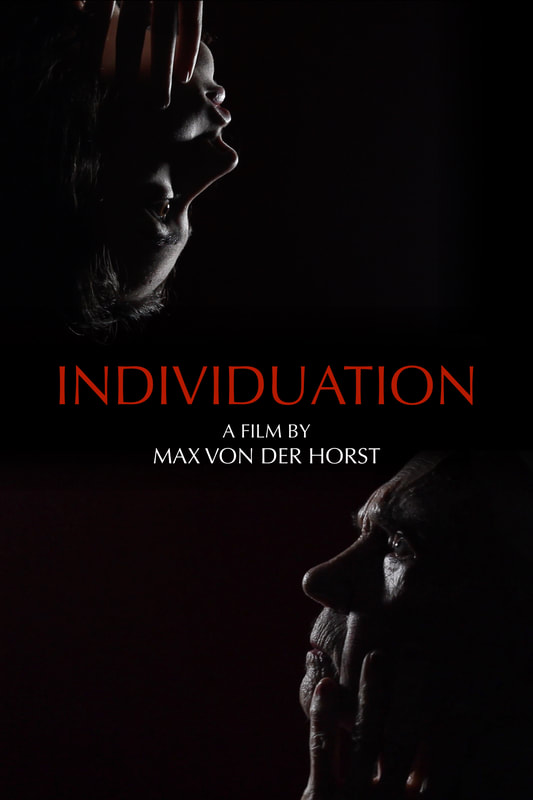Individuation (ˌin-də-ˌvi-jə-ˈwā-shən)
1. The process in the analytic psychology of C. G. Jung by which the self is formed by integrating elements of the conscious and unconscious mind.
2. The process by which individuals in society become differentiated from one another.
CARL JUNG
"One does not become enlightened by imagining figures of light
but by making the darkness conscious."
1. The process in the analytic psychology of C. G. Jung by which the self is formed by integrating elements of the conscious and unconscious mind.
2. The process by which individuals in society become differentiated from one another.
CARL JUNG
"One does not become enlightened by imagining figures of light
but by making the darkness conscious."
|
Written & Directed By: Max Von der Horst
Producer: Max Von der Horst Cinematographer: Max Von der Horst Editor: Max Von der Horst Sound Design: Max Von der Horst Production Design: Max Von der Horst Music by: Glenn John Arnowitz |
Starring:
Emma Jakubik Vondi William O'Dell Jonah Bowen Ethan Tuomala Paige Kent Chloe Borthwick |
|
|
|
|
|
|
|
|
|
|
|
|
|
|
|
|
|
|
ARTIST STATEMENT
This film is a compilation of a 12-part Senior Project thesis created over the course of 12 weeks exploring the concept of Individuation, a psychological process discussed in Jungian Psychology. Individuation is a formation of the Self (the whole personality) as a result of the union between the conscious and unconscious mind that occurs by confronting the archetypes, emotions and impulses within ourselves through dreams, visions, and interactions. In this process, the unrecognized parts of our psyche are revealed to us and we become more aware of our inner world and its effect on our waking lives.
We experience different stages over time and encounter various layers and depths of our unconscious mind in which different archetypes are confronted. The first stage, Nigredo (blackening), we experience the darker aspects of ourselves, where the Shadow first reveals itself. As we progress through the process, we enter the Albedo (illumination) stage, where we experience enlightenment and are met with our Persona, or the personality we put out to society. In the final stage, Rubedo (reddening) we are met with the Animus, or the opposite-sex counterpart. Once we’ve confronted all of these archetype, the fully-realized Self is developed, and the individual has become whole and their full personality and potential is achieved.
Through these films, I have represented this complex idea through abstractions and symbolism to achieve the sense that the viewer has been placed inside a person’s dreams and inner world. The films guide you through the process of Individuation, and experience the development of and individual's personality as they progress through their psyche. I use color and aspect ratio to convey the sense of advancement through the process. As the films progress, the aspect ratio begins to expand as a representation of the individual’s expanding consciousness. The films transition from black & white into color as a way to portray the stages you are in. In Nigredo, there are fades to black, in Albedo, fades to white, and ultimately in the Rubedo stage, it transitions into color and I make prominent use of red to place the viewer further into the qualities of the Individuation process through the language of dreams. I began with an infant and ended with an old woman, in order to express how Individuation is a lifelong process. I hope through these abstractions, the viewer may gain some insight into the wonderful complexity of dreams and the hidden worlds & mythologies that lie within our mind.
We experience different stages over time and encounter various layers and depths of our unconscious mind in which different archetypes are confronted. The first stage, Nigredo (blackening), we experience the darker aspects of ourselves, where the Shadow first reveals itself. As we progress through the process, we enter the Albedo (illumination) stage, where we experience enlightenment and are met with our Persona, or the personality we put out to society. In the final stage, Rubedo (reddening) we are met with the Animus, or the opposite-sex counterpart. Once we’ve confronted all of these archetype, the fully-realized Self is developed, and the individual has become whole and their full personality and potential is achieved.
Through these films, I have represented this complex idea through abstractions and symbolism to achieve the sense that the viewer has been placed inside a person’s dreams and inner world. The films guide you through the process of Individuation, and experience the development of and individual's personality as they progress through their psyche. I use color and aspect ratio to convey the sense of advancement through the process. As the films progress, the aspect ratio begins to expand as a representation of the individual’s expanding consciousness. The films transition from black & white into color as a way to portray the stages you are in. In Nigredo, there are fades to black, in Albedo, fades to white, and ultimately in the Rubedo stage, it transitions into color and I make prominent use of red to place the viewer further into the qualities of the Individuation process through the language of dreams. I began with an infant and ended with an old woman, in order to express how Individuation is a lifelong process. I hope through these abstractions, the viewer may gain some insight into the wonderful complexity of dreams and the hidden worlds & mythologies that lie within our mind.

